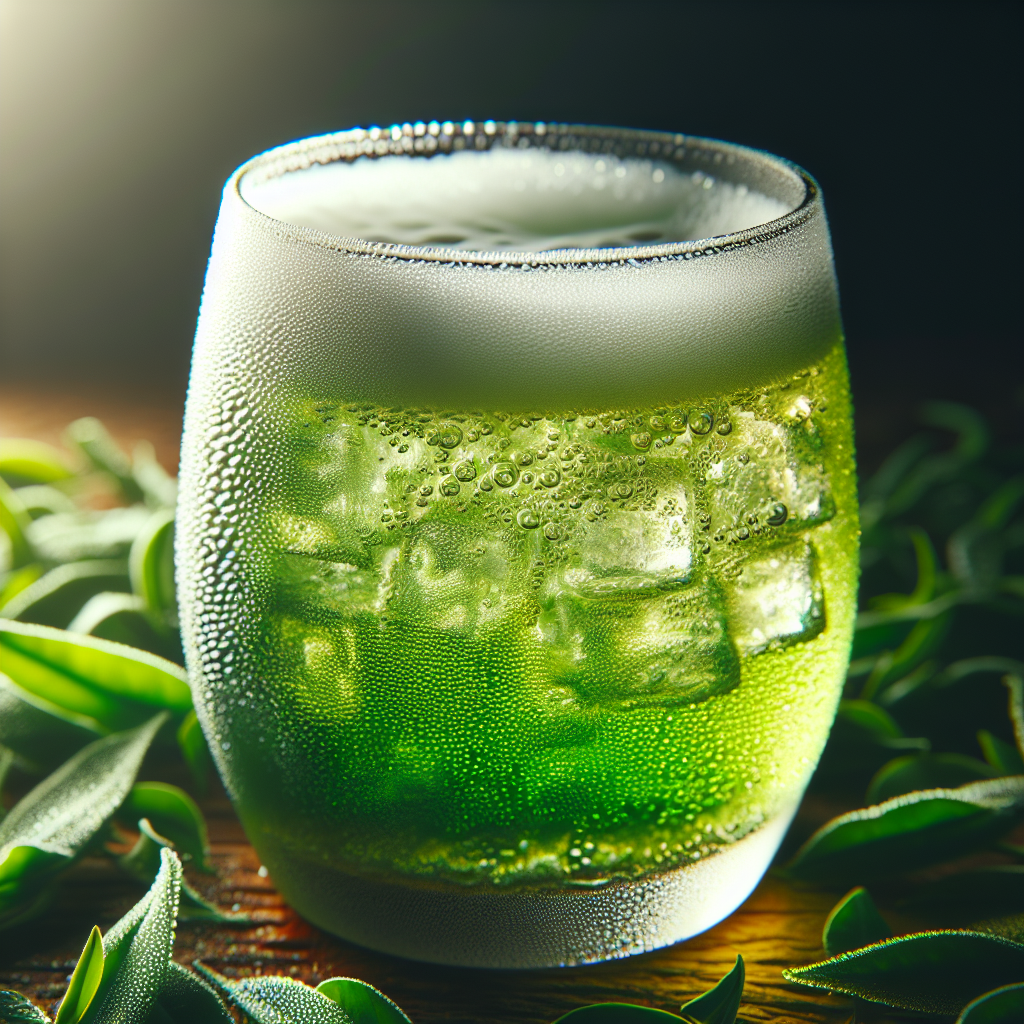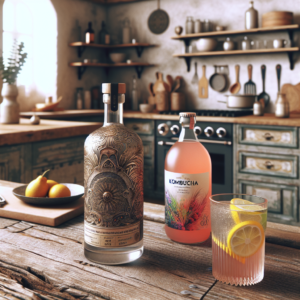
At a glance: Crafting Hard Kombucha with Green Tea
- Choose high-quality green tea for a rich flavor base.
- Balance sugar content without overpowering sweetness.
- Understand primary and secondary fermentation processes for optimal alcohol content.
- Infuse with fruits or botanicals to create a unique hard kombucha flavor profile.
- Control carbonation to achieve the perfect fizz in your hard kombucha.
The Art of Crafting Flavorful Hard Kombucha
There’s something magical about transforming simple ingredients like tea and sugar into a bubbly, alcoholic beverage that not only tastes amazing but is also filled with probiotics. This is the essence of crafting hard kombucha, a delightful twist on the traditional fermented tea that has been enjoyed for centuries. With the right guidance, anyone can create a delicious batch of hard kombucha right at home. Let’s dive into the process.
Choosing the Perfect Tea
When it comes to kombucha, the tea you choose is not just a starting point; it’s the soul of your beverage. Green tea is an excellent choice for hard kombucha because it offers a delicate flavor that complements the natural tartness of the fermented drink. But don’t just grab any green tea off the shelf. Opt for high-quality, loose-leaf varieties to ensure a cleaner taste and a more nutrient-rich brew. Here’s what you need to consider:
- The origin of the tea: Different regions produce green teas with distinct flavors.
- The quality of the leaves: Whole leaves are preferable to broken ones or tea dust.
- Organic options: These are free from pesticides and tend to provide a purer taste.
Remember, the better the tea, the better the base for your hard kombucha.
Infusion of Green Tea

Green tea infuses your hard kombucha with a refreshing flavor and a host of antioxidants. But it’s not as simple as just steeping tea. You need to consider the temperature of the water, the steeping time, and even the vessel you’re using. Here’s how to do it right:
Optimal Steeping Techniques
For the perfect green tea infusion:
- Heat water to about 175°F (80°C)—not boiling—to avoid bitterness.
- Steep the tea for about 3 minutes. Oversteeping can release tannins that make the tea bitter.
- Use about 1-2 teaspoons of loose-leaf tea per 8 ounces of water, depending on how strong you like your kombucha.
These steps will ensure a smooth and flavorful green tea base for your hard kombucha.
Green Tea Varieties and Their Unique Flavors
Not all green teas are created equal. From the nutty notes of Dragonwell to the sweet undertones of Sencha, each variety offers something special. Here’s a quick comparison:
|
Green Tea Variety |
Tasting Notes |
|---|---|
|
Sencha |
Grassy, sweet, and slightly astringent |
|
Dragonwell |
Nutty, smooth, with a hint of sweetness |
|
Matcha |
Rich, creamy, and full-bodied |
Experiment with different types to find your favorite flavor profile for hard kombucha.
Timing the Green Tea Infusion for Maximum Flavor
Timing is everything. Infuse the green tea just long enough to extract its essence without turning it bitter. As a rule of thumb, start tasting your tea after about two minutes of steeping and stop once you’ve hit the flavor intensity you’re looking for. Remember, the SCOBY will also contribute to the final taste, so leave room for its flavor to shine through.
Balancing Sugar and Acidity
Sugar is not just a sweet treat; it’s the fuel for the fermentation process. However, too much sugar can lead to an overly sweet hard kombucha, while too little might not provide enough food for the SCOBY (Symbiotic Culture Of Bacteria and Yeast) to do its job. The key is to find the sweet spot—pun intended. Here’s a simple guideline:
- For each gallon of tea, use about one cup of sugar.
- Always dissolve the sugar in hot tea before adding it to your brewing vessel.
- Choose cane sugar for its clean fermenting qualities.
Understanding Fermentation Stages
The fermentation process is where the magic happens. It’s broken down into two stages: primary and secondary. In the primary stage, the SCOBY digests the sugar, turning it into alcohol and creating that distinctive kombucha tang. This stage typically takes 7 to 14 days, depending on the temperature and the strength of your SCOBY
During secondary fermentation, you’ll remove the SCOBY and add your flavorings, like fruit or herbs. This is also when hard kombucha develops its carbonation. Seal your brew in airtight bottles and let it sit for a few more days. The yeast will consume the remaining sugars, producing carbon dioxide and increasing the alcohol content. Monitor the fizz by burping the bottles to prevent explosions
The Role of Yeast in the Alcohol Fermentation Process
Now, let’s talk about yeast, the unsung hero in the world of hard kombucha. Yeast is a microorganism that turns the sugars in your tea into alcohol and carbon dioxide. This process is called fermentation. But it’s not just any yeast you want; you’ll need a strain that can handle the acidic environment of kombucha and produce the right amount of alcohol without compromising the taste.
For hard kombucha, consider adding a champagne yeast to your brew. It’s a reliable choice because it ferments quickly and cleanly, leaving behind minimal flavors that could clash with the delicate notes of your green tea kombucha. Just sprinkle the yeast into your cooled tea before adding your SCOBY, and it will get to work right away.
*Most importantly, the longer you allow for secondary fermentation, the drier and more alcoholic your kombucha will become*
Measuring and Testing Alcohol Content Safely
As you venture into making hard kombucha, it’s important to keep an eye on the alcohol content. Not only for taste but also for legal reasons, as homemade beverages can’t exceed certain limits without a license. To measure the alcohol level, you can use a hydrometer, a tool that gauges the density of your kombucha before and after fermentation.
Here’s how to use it:
- Sanitize the hydrometer and place it in a sample of your unfermented tea mixture.
- Record the specific gravity reading.
- Do the same once fermentation is complete.
- Use a simple calculation to determine the alcohol content based on the change in specific gravity.
This will give you a good idea of how strong your hard kombucha is.
Flavoring with Botanicals and Fruit
Flavor is the soul of hard kombucha, and this is where you can really let your creativity shine. Whether you’re a fan of bold, fruity notes or subtle herbal undertones, the possibilities are endless.
When adding flavors, do so during the secondary fermentation process. This is after you’ve removed the SCOBY and right before you bottle your kombucha. The residual yeast will continue to ferment any added sugars from fruits or herbs, which not only creates alcohol but also infuses the flavors into your brew.
Experimenting with Herbal Infusions
Herbs can add a refreshing twist to your hard kombucha. Consider these popular choices:
- Mint for a cool, crisp finish.
- Lavender for a floral touch.
- Rosemary for a piney, earthy note.
Remember, a little goes a long way with herbs. Start with a small amount and taste regularly to prevent overpowering your brew.
For an example, adding just a few sprigs of fresh mint to your kombucha can transform it into a mojito-inspired delight. It’s all about finding the right balance that complements the green tea base.
And if you’re feeling adventurous, blend different herbs to create your own signature flavor.
Adding Fresh vs. Dried Fruit
When it comes to fruit, you have two choices: fresh or dried. Fresh fruit will give you a more vibrant flavor, while dried fruit imparts a deeper, more concentrated taste. Here’s how to use them:
- Add fresh fruit directly to the kombucha after the primary fermentation.
- Use dried fruit sparingly as it’s more potent than fresh.
- Chop the fruit into small pieces to maximize the surface area for flavor extraction.
Carbonation: Fizz Without the Fuss
Carbonation is what gives hard kombucha its refreshing zing. Achieving the perfect level of fizz is a delicate dance between sugar, yeast, and time.
Natural carbonation occurs when the yeast in your kombucha continues to ferment the sugars during the secondary fermentation. This process creates carbon dioxide, which is trapped in the bottle, giving your kombucha its bubbles.
Natural Carbonation Vs. Forced Carbonation Methods
While natural carbonation is the traditional way to carbonate kombucha, forced carbonation is an alternative that offers more control. This method involves adding carbon dioxide directly to your brew using specialized equipment. It’s faster, but it also requires more investment and technical know-how.
Most homebrewers stick with natural carbonation because it’s simpler and preserves the authentic kombucha experience.
Controlling Carbonation Levels
Controlling the level of carbonation in your hard kombucha is crucial for the perfect sip. Here’s how to manage it:
- Bottle your kombucha in clean, airtight containers.
- Add a small amount of sugar to feed the yeast and create carbonation.
- Check the fizz daily by gently opening the bottle to release some pressure.
This process, known as ‘burping’ your bottles, will help you avoid over-carbonation and potential bottle explosions.
Timing and Temperature: Keys to Bubbly Success
Timing and temperature play a significant role in carbonation. Warmer temperatures speed up fermentation, which means faster carbonation. Aim for a room temperature of around 70-75°F (21-24°C) for the best results. And remember, the longer you let your kombucha ferment, the more carbonated it will become. After a few days, start tasting and when it reaches your desired level of fizz, it’s time to refrigerate to slow down the fermentation and lock in the carbonation.
Common Pitfalls in Carbonating Kombucha and How to Avoid Them
Carbonation can be tricky, and there are a few common pitfalls:
- Over-carbonation: This can lead to messy overflows or even bottle explosions. Avoid this by burping your bottles regularly.
- Under-carbonation: If your kombucha isn’t fizzy enough, it may need more time or a bit more sugar to reactivate the yeast.
- Inconsistent carbonation: This can happen if the sugar isn’t evenly distributed. Make sure to stir your kombucha gently before bottling.
With these tips in mind, you’ll achieve the perfect level of carbonation for your hard kombucha every time.
Finishing Touches: Bottling and Storage
The last step in the kombucha-making process is bottling and storage, which are crucial for maintaining flavor and carbonation.
Choosing the Right Bottles for Your Brew
Not all bottles are created equal when it comes to kombucha. You’ll need strong, airtight bottles that can handle the pressure of carbonation. Swing-top bottles are a popular choice for homebrewers because they’re reusable and seal tightly. Just make sure to sterilize them before use to prevent any unwanted bacteria from spoiling your batch.
Remember, the quality of your bottles directly impacts the quality of your kombucha.
Sealing Techniques to Maintain Carbonation and Flavor
Once your kombucha is bottled, the sealing technique you use will determine how well it retains its carbonation and flavor. If using swing-top bottles, make sure the seal is secure but not overly tight; you want to avoid any carbonation escaping or, conversely, pressure building up too much. Screw-top bottles should be tightened firmly but not forced. The goal is to keep the kombucha airtight to preserve the fizziness and prevent any contamination.
Optimizing Shelf Life Through Proper Storage
Proper storage of your hard kombucha can extend its shelf life and maintain its quality. Keep your bottled kombucha in a cool, dark place away from direct sunlight. The back of a pantry or a basement are ideal spots. Refrigeration is not necessary until you’re ready to drink it, but once chilled, keep it refrigerated to slow down any further fermentation and preserve its current state.
Generally, hard kombucha can be stored for several months, but always check for signs of spoilage, such as off-odors or mold, before consumption.
Labeling and Tracking Your Homemade Batches
Labeling your kombucha is more than just a way to show off your craft; it’s a practical method to keep track of different flavors and fermentation times. Use labels to note the following:
- The date of bottling
- The type of tea and flavorings used
- The expected alcohol content
This information can help you replicate successful batches and learn from those that didn’t turn out as well.
FAQ
Can I Make Hard Kombucha Without a SCOBY?
Technically, no. The SCOBY is essential for kombucha fermentation. It contains the bacteria and yeast needed to convert the sugars in the tea into alcohol and acids. Without it, you wouldn’t have kombucha, hard or otherwise.
Is Green Tea-Based Kombucha Healthier Than Other Varieties?
Green tea is renowned for its health benefits, including high levels of antioxidants. While the health benefits of kombucha are largely the same regardless of the tea used, green tea-based kombucha can offer additional antioxidants that may not be as prevalent in other teas.
How Long Does It Take to Brew Hard Kombucha?
The brewing time for hard kombucha can vary. The primary fermentation typically takes 7 to 14 days, while the secondary fermentation, which develops the alcohol content and carbonation, can take an additional 2 to 14 days. Always taste your kombucha throughout the process to achieve your desired level of fermentation.
What Are the Signs of a Successful Kombucha Fermentation?
Successful kombucha fermentation is indicated by a tangy, slightly vinegary aroma, a balance of sweet and sour flavors, and the presence of natural carbonation. The SCOBY should be healthy-looking, thick, and white or light brown. If there are signs of mold or an off smell, the batch should be discarded.
Can Hard Kombucha Be Mixed with Other Alcoholic Beverages?
Yes, hard kombucha can be mixed with other alcoholic beverages to create unique cocktails. However, be mindful of the alcohol content when mixing to ensure the drink remains enjoyable and safe to consume.



